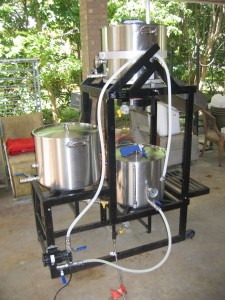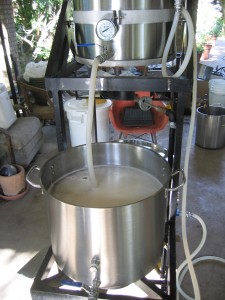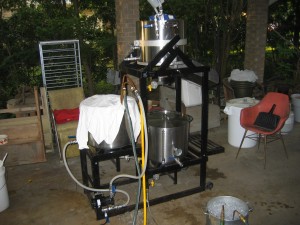
Shiny. My 10-gallon (38-L) brewing rig — a tippy dump sculpture made by MoreBeer. The three vessels — HLT, mash/lauter tun, and kettle — are made from 15-gallon (57-L) stainless steel pots.
More beer! Homebrewers who’ve been at it for a few years often heed this call and scale up from 5 gallons (19 L) to 10 gallons (38 L) or more. The fundamentals of brewing beer don’t change no matter what scale you’re brewing at. In addition, scaling from 5 gallons (19 L) to 10 gallons (38 L) requires no new skills — you just need a bigger set of vessels than your 5-gallon (19-L) brewery.
Scaling up to 10 gallons (around 40 L) has one big benefit — you yield twice the volume of beer while your brewday is roughly the same length. Depending on your equipment, it may take slightly longer to heat your water or chill your wort. However, with a brewery designed to to make 10 gallons (38 L) of wort per batch, the time spent brewing will be equivalent to brewing 5 gallons (19 L).
There are a few incidental benefits to scaling up. For instance, your mash volume is going to be larger, and consequently have a smaller surface-to-volume ratio. As such, it will require less insulation or periodic heating to keep the mash temperature steady.
On the other hand, there are some minor drawbacks that come with size. You’ll use more energy (likely in the form of propane) for heating water and wort, and you’ll use more water chilling the wort. However, the biggest drawback is that there is not as much inexpensive equipment that can be repurposed for brewing at this scale.
Equipment
Bigger vessels for the hot side of your brewery are not too hard to come by. Decommissioned (and legally-obtained) Sanke kegs (15.5 gallons) can be converted to HLTs, mash/lauter tuns, and kettles. Restaurant supply stores are a good place to look for large stainless steel pots. (I once found a 20-gallon (~80-L) aluminum pot at a camping store.) And of course, custom-built 10-gallon (38-L) and larger brewing rigs are sold by a few of the larger homebrew shops. The most elaborate of these have controllers to measure and automatically maintain mash temperature (by turning burners on and off and recirculating the wort via pump). For people with metalworking experience, designs for 10-gallon (38-L) and larger breweries can be found on the internet.
Finding fermenters for brewing at this volume can be more difficult. Demijohns — big glass vessels sometimes used by winemakers — are the closest thing to carboys. They come in 10-gallon (~40-L) and 15-gallon (~60-L) versions in many home winemaking shops and sell for $80–100 (US). For 10-gallon (~40-L) batches, you’d need to the 15-gallon (~60-L) size to leave room for the kräusen during fermentation. Demijohns usually come in a little plastic basket with handles.
Another inexpensive option is food-grade garbage cans — another vessel used frequently by home winemakers. You can use these to do semi-open fermentations (as the lids don’t seal), then rack the beer promptly to two (or more) carboys when fermentation ceases. Or, you can modify the lids so they do seal and install a fermentation lock. Obviously, the garbage can needs to be dedicated to fermentation. These go for $25 (US) and up at hardware stores. (Look at the plastic code to see the bin’s rating with respect to food safety. Also, realize that these bins were not made with fermentation in mind; read up on plastic codes and make your own judgement with regards to if these are safe.)
The gold standard for homebrewers is stainless steel cylindro-conical fermenters. These are great to work with and come in a variety of sizes. They are scaled-down versions of what many pro brewers use. The cone at the bottom makes harvesting yeast and separating the beer from the yeast easy. However, they are much more expensive than any of the previously mentioned options, typically starting at over $500 (US).
Because vessels suitable for fermenting 10 gallons (38 L) of beer are harder to come by, many brewers simply split their wort between two bucket or carboy fermenters. This is a little more work, but “regular” sized carboys fit in most makeshift fermentation chambers (converted chest freezers, etc.).
As with fermenters, finding suitable options for packaging is a littler harder at this scale. Ten-gallon (38-L) Corny kegs do exist, but they are hard to find and pricey when you do find them. (I paid around $200 used a few years ago.) Most brewers simply package their beers in two 5-gallon (19-L) Corny kegs, which fit in most 5-gallon (19-L) serving chambers (“keezers” or converted refrigerators).
The one new piece of equipment that comes in handy for brewing at this scale is a pump to move liquids. Picking up and carrying vessels is a lot more difficult and dangerous at this scale as a vessel full of 10 gallons (38 L) of wort can weigh 90 lbs. (~40 kg) or more. A new, food-grade, high-temperature pump suitable for homebrewing costs in the neighborhood of $150.
Do-it-Yourselfers have come up with many other solutions to homebrewing at 10-gallons (38-L) and beyond, and you can find ideas all over the internet. Many internet brewing forums have sections dealing with equipment and DIY projects. For many years, RIMS and HERMS breweries were very popular. These rigs circulated the mash liquid through a heating loop to maintain rest temperatures and even heat the mash through a step mash.
Techniques
Once you’ve got your 10-gallon (38-L) brewery set up, brewing is going to proceed almost exactly as it did at the 5-gallon (19-L) scale, with a few minor points to consider. If you were still using a hand-cranked grain mill for making 5-gallon (19-L) batches, it’s time to motorize your mill somehow. When running off your wort, you’ll have twice as much liquid to drain from your mash/lauter tun in the same amount of time. So, the volume flowing into your kettle will be more than you’re used to. Heating and cooling may take a bit more time. A counter-flow chiller or plate chiller is something to consider if your old immersion chiller doesn’t cut it at a larger volume. If you’re fermenting in two carboys, you’ll need to split the yeast from your yeast starter as equally as you can manage. Having two sanitized glass measuring cups on hand can help you with this. If you’re fermenting in one vessel, such as a large cylindro-conical, keep in mind it will be very heavy when full. If possible, place the fermenter where it will reside during fermentation and pump the chilled wort to it. (Alternately, take the wort to it in shifts in a sanitized bucket.)
Conclusion
If you’ve got a recipe you really like, being able to brew 10 gallons (19 L) of it at a time can be a great thing.



Speak Your Mind